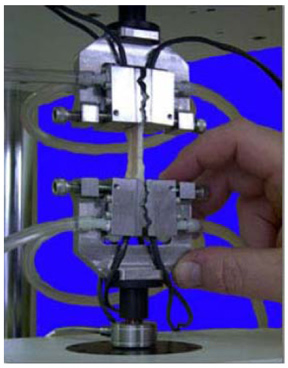![]() Self Adjusting Vacuum Grips for Mechanical Testing of Small, Very Soft Biological Tissue
Self Adjusting Vacuum Grips for Mechanical Testing of Small, Very Soft Biological Tissue
PI: Dr. Henry Haslach
Introduction
Brain tissue in model animals must be mechanically tested to lay the scientific foundation for clinical evaluation of human traumatic brain injury. Mechanical tests are performed on soft biological tissue, such as cardiovascular tissue, ligaments, skin, etc, to measure the deformation as a function of load, to determine the fracture load and to make other similar measurements in order to predict the in vivo behavior both of healthy and diseased tissue. One of the difficulties in mechanical testing of soft biological tissue is that of gripping the specimen so that a tensile test including load to fracture, creep and stress relaxation, may be conducted. The usual problems are that it is easy to crush or tear the soft specimen in the grips and that the specimen slips from grips. Also as soft tissue is loaded, the specimen thins in the grips so that the grips have to be continually closed to maintain the hold on the specimen during the test. Making the adjustment manually risks disturbing the specimen.
Vacuum devices have been used for decades in industrial applications to lift objects. For example, in the small office offset printing press of 50 years ago, vacuum lifts each sheet off the stack of paper to be printed to the rollers that draw the sheet through the press. A typical low-tech mechanism is a simple suction cup with a handle that is attached to the device to be lifted.
Design Work
The tissue must be gripped under a light and easily controlled load in order to minimize damage to the specimens from the grips. The grips must be capable of applying forces of less than 10 Newtons.
A common technique used in grips for soft biological tissue is to apply air pressure to one end of pivoted grips so that the free end clamps the specimen. A problem with this method is that enough force may be inadvertently applied to crush the tissue. The force is held constant by the fixed air pressure. Even with if the air pressure is manually controlled, the force does not automatically adjust to thinning of the specimen. In the proposed design, the vacuum induced pulls grip blocks to the specimen, exerting a small load that is large enough to hold the specimen under typical test loads.
The constraints on the design are: 1. The grip must be able to withstand a load of 250N and must hold a specimen with cross-section in the range of 2 by 2 to 25 by 10 mm; 2. The grip cannot deform more than 0.01 mm under 250N; 3. The grip must operate in 50-100°F and 80-100% relative humidity; 4. The weight of material in the upper grip must be less than 2N; 5. The grip face must generate a frictional force of 25N; and 6. The vertical dimension of the face must be greater than 8 mm.
The designed grip must perform the following functions: 1. Secure the specimen during the test; 2. Create friction between the specimen and the face of the grip; 3. Adjust for specimen size; 4. Align the specimen to prevent bending and twisting of the specimen; 5. Ensure the specimen is vertical; 6. Allow hydration of the specimen; and 7. Permit optical measurement of the specimen deformation.
The design is to be validated by using it to test very soft rat brain tissue. An invention disclosure for a version of these grips designed for larger samples of moderately soft tissue such as artery tissue has been submitted to the University of Maryland Office of Technology Commercialization.

Commercial Bose Grips

